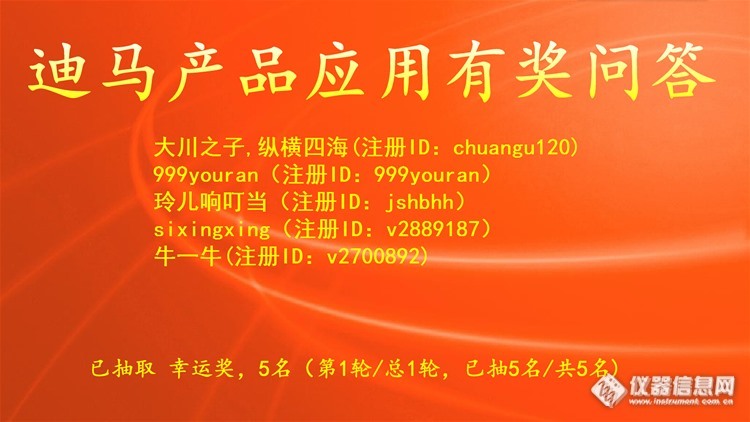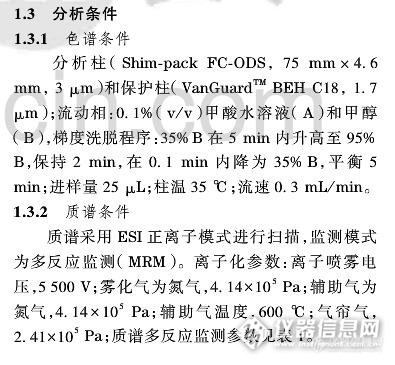苯酚类化合物,4-氨基安替比林分光光度法,低浓度的标液反应后用三氯甲烷萃取后测吸光度时,吸光度值一直不稳定是什么原因,有前辈之前碰到过这种情况么?该怎么解决。
氨基安替比林测定苯酚类化合物中,吸收液要求是水中加入碳酸钠至PH 10左右,但是PH计测定出的和PH纸悬殊很大啊,这个有木有什么定量的配置方法?此外 ,直接比色法中,曲线的 截距和斜率有没有特殊要求?如果谁有做出的曲线,能否发上来看下?
HJ834-2017土壤中半挥发性有机物的测定,硅酸镁小柱对苯酚类化合物有吸附能力吗,还是会直接随溶剂流下去
苯酚类化合物的低浓度标准曲线,就是萃取后去测吸光度的那一条,斜率大概在什么范围里面啊?
求高手指路 我正在开展 水中 酚类化合物 的测定 这一个项目。想问一下有谁有这个项目的经验 。特别是邻氯苯酚 2-氯酚 这两个,我想用液相色谱来检测,哪改怎样做?由于我现在实验室条件不足,水和废水 酚类化合物 高效液相色谱法 (HPLC) (c) 上所需的GDX-502 及其装置,我没有,想问一下 我能用前处理 我可以用 20孔真空提取装置 Sep-Pak固相萃取小柱 来代替 吗?检测仪器 我现有 waters 486 液相色谱仪 600泵 色谱柱 C18 和 多环芳烃分析专用柱 行吗?请求高手指点 很急。。。。。万分感激
HJ/T32酚类化合物中的标准曲线使用液可以用苯酚的标液吗?还是需要自己配?有没有渠道购买现成的标液
酚类化合物以苯酚计是默认测出来的就是苯酚吗?
GB11889-89 水质 苯胺类化合物的测定中提到在酸性条件下测定时苯酚含量高于200mg/L时,对本方法有正干扰,不知道哪位大侠有遇到这种情况,在不知是否含有苯酚的情况下按照标准的方法进行测试会出现些什么情况?比如显色颜色不对?还是其他?
[align=left][font='times new roman'][size=18px]S[/size][/font][font='times new roman'][size=18px]il[/size][/font][font='times new roman'][size=18px]-P-C12[/size][/font][font='times new roman'][size=18px]色谱柱分离硫脲类化合物[/size][/font][font='times new roman'][size=18px]/[/size][/font][font='times new roman'][size=18px]苯酚类化合物[/size][/font][font='times new roman'][size=18px]/[/size][/font][font='times new roman'][size=18px]磺胺类化合物[/size][/font][/align][font='times new roman'][size=16px]为了考察[/size][/font][font='times new roman'][size=16px]Sil[/size][/font][font='times new roman'][size=16px]-P-C12[/size][/font][font='times new roman'][size=16px]色谱柱的分离性能,选取了七种小分子化合物[/size][/font][font='times new roman'][size=16px]——[/size][/font][font='times new roman'][size=16px]硫脲类、苯酚类、磺胺类、酰胺类、黄酮类、核苷[/size][/font][font='times new roman'][size=16px]/[/size][/font][font='times new roman'][size=16px]核酸碱基类和烷基苯类。首先是三种硫脲类化合物[/size][/font][font='times new roman'][size=16px],[/size][/font][font='times new roman'][size=16px]图[/size][/font][font='times new roman'][size=16px]1[/size][/font][font='times new roman'][size=16px]为[/size][/font][font='times new roman'][size=16px]二乙基硫脲、亚乙基硫脲和烯丙基硫脲[/size][/font][font='times new roman'][size=16px]的色谱分离图。以乙腈[/size][/font][font='times new roman'][size=16px]-[/size][/font][font='times new roman'][size=16px]水([/size][/font][font='times new roman'][size=16px]97[/size][/font][font='times new roman'][size=16px]:[/size][/font][font='times new roman'][size=16px]3[/size][/font][font='times new roman'][size=16px],[/size][/font][font='times new roman'][size=16px]v/v[/size][/font][font='times new roman'][size=16px])进行洗脱,三种物质可在[/size][/font][font='times new roman'][size=16px]6 min[/size][/font][font='times new roman'][size=16px]内达到基线分离,分离度分别为[/size][/font][font='times new roman'][size=16px]9.21[/size][/font][font='times new roman'][size=16px]和[/size][/font][font='times new roman'][size=16px]5.04[/size][/font][font='times new roman'][size=16px],拖尾因子[/size][/font][font='times new roman'][size=16px]分别为[/size][/font][font='times new roman'][size=16px]1[/size][/font][font='times new roman'][size=16px].07[/size][/font][font='times new roman'][size=16px]、[/size][/font][font='times new roman'][size=16px]1[/size][/font][font='times new roman'][size=16px].45[/size][/font][font='times new roman'][size=16px]和[/size][/font][font='times new roman'][size=16px]1[/size][/font][font='times new roman'][size=16px].22[/size][/font][font='times new roman'][size=16px],最高理论塔板数为[/size][/font][font='times new roman'][size=16px]6[/size][/font][font='times new roman'][size=16px]1[/size][/font][font='times new roman'][size=16px],[/size][/font][font='times new roman'][size=16px]1[/size][/font][font='times new roman'][size=16px]00[/size][/font][font='times new roman'][size=16px] N/[/size][/font][font='times new roman'][size=16px]m[/size][/font][font='times new roman'][size=16px]。[/size][/font][align=center][img]" style="max-width: 100% max-height: 100% [/img][/align][align=center][font='times new roman']图[/font][font='times new roman']1[/font][font='times new roman'] [/font][font='times new roman'] [/font][font='times new roman']硫脲类物质在[/font][font='times new roman']Sil-P-C12[/font][font='times new roman']色谱柱中的分离谱图[/font][/align][align=center][font='times new roman']色谱条件:流动相,乙腈[/font][font='times new roman']-[/font][font='times new roman']水[/font][font='times new roman']([/font][font='times new roman']97:3[/font][font='times new roman'],[/font][font='times new roman']v/v[/font][font='times new roman']);检测波长,[/font][font='times new roman']214 nm[/font][font='times new roman'];流速,[/font][font='times new roman']1.0 mL/min[/font][/align][align=center][font='times new roman']分析物:[/font][font='times new roman']1. [/font][font='times new roman']二乙基硫脲;[/font][font='times new roman']2. [/font][font='times new roman']亚乙基硫脲;[/font][font='times new roman']3. [/font][font='times new roman']烯丙基硫脲[/font][/align][align=center][font='times new roman']Separation chromatogram of thiocarbamides on the Sil-P-C12 column[/font][/align][align=center][font='times new roman']Chromatographic conditions: mobile phase, ACN-H[/font][font='times new roman'][sub][size=13px]2[/size][/sub][/font][font='times new roman']O (97:3, v/v) detection wavelength, 214 nm flow rate, 1.0 mL/min[/font][/align][align=center][font='times new roman']Analytes: 1. diethyl thiourea 2. ethylene thiourea 3. allylthiourea[/font][/align][align=left][font='times new roman'][size=18px]3.3.4 S[/size][/font][font='times new roman'][size=18px]il[/size][/font][font='times new roman'][size=18px]-P-C12[/size][/font][font='times new roman'][size=18px]色谱柱分离苯酚类化合物[/size][/font][/align][font='times new roman'][size=16px]采用苯酚类化合物进一步考察了[/size][/font][font='times new roman'][size=16px]Sil[/size][/font][font='times new roman'][size=16px]-P-C12[/size][/font][font='times new roman'][size=16px]色谱柱的分离性能。[/size][/font][font='times new roman'][size=16px]图[/size][/font][font='times new roman'][size=16px]2[/size][/font][font='times new roman'][size=16px]为[/size][/font][font='times new roman'][size=16px]对甲酚、对氯苯酚、双酚[/size][/font][font='times new roman'][size=16px]A[/size][/font][font='times new roman'][size=16px]、对乙酰氨基酚和[/size][/font][font='times new roman'][size=16px]2[/size][/font][font='times new roman'][size=16px]-[/size][/font][font='times new roman'][size=16px]羟基苯砜五种苯酚类化合物[/size][/font][font='times new roman'][size=16px]的色谱分离图。以乙腈[/size][/font][font='times new roman'][size=16px]-[/size][/font][font='times new roman'][size=16px]水([/size][/font][font='times new roman'][size=16px]9[/size][/font][font='times new roman'][size=16px]7:3[/size][/font][font='times new roman'][size=16px],[/size][/font][font='times new roman'][size=16px]v/v[/size][/font][font='times new roman'][size=16px])进行洗脱,[/size][/font][font='times new roman'][size=16px]五[/size][/font][font='times new roman'][size=16px]种物质可在[/size][/font][font='times new roman'][size=16px]8[/size][/font][font='times new roman'][size=16px] min[/size][/font][font='times new roman'][size=16px]内达到基线分离,[/size][/font][font='times new roman'][size=16px]分离度分别为[/size][/font][font='times new roman'][size=16px]2.08[/size][/font][font='times new roman'][size=16px]、[/size][/font][font='times new roman'][size=16px]6[/size][/font][font='times new roman'][size=16px].05[/size][/font][font='times new roman'][size=16px]、[/size][/font][font='times new roman'][size=16px]4[/size][/font][font='times new roman'][size=16px].86[/size][/font][font='times new roman'][size=16px]和[/size][/font][font='times new roman'][size=16px]1[/size][/font][font='times new roman'][size=16px]5.63[/size][/font][font='times new roman'][size=16px],最高理论塔板数可达[/size][/font][font='times new roman'][size=16px]7[/size][/font][font='times new roman'][size=16px]7[/size][/font][font='times new roman'][size=16px],900[/size][/font][font='times new roman'][size=16px] N/[/size][/font][font='times new roman'][size=16px]m[/size][/font][font='times new roman'][size=16px],且色谱图峰型良好,[/size][/font][font='times new roman'][size=16px]拖尾因子[/size][/font][font='times new roman'][size=16px]分别为[/size][/font][font='times new roman'][size=16px]1[/size][/font][font='times new roman'][size=16px].09[/size][/font][font='times new roman'][size=16px]、[/size][/font][font='times new roman'][size=16px]1[/size][/font][font='times new roman'][size=16px].07[/size][/font][font='times new roman'][size=16px]、[/size][/font][font='times new roman'][size=16px]0[/size][/font][font='times new roman'][size=16px].94[/size][/font][font='times new roman'][size=16px]、[/size][/font][font='times new roman'][size=16px]0.97[/size][/font][font='times new roman'][size=16px]和[/size][/font][font='times new roman'][size=16px]0[/size][/font][font='times new roman'][size=16px].93[/size][/font][font='times new roman'][size=16px]。[/size][/font][align=center][img]" style="max-width: 100% max-height: 100% [/img][/align][align=center][font='times new roman']图[/font][font='times new roman']2[/font][font='times new roman'] [/font][font='times new roman']苯酚类物质在[/font][font='times new roman']Sil-P-C12[/font][font='times new roman']色谱柱中的分离谱图[/font][/align][align=center][font='times new roman']色谱条件:流动相,乙腈[/font][font='times new roman']-[/font][font='times new roman']水[/font][font='times new roman']([/font][font='times new roman']97:3[/font][font='times new roman'],[/font][font='times new roman']v/v[/font][font='times new roman']);检测波长,[/font][font='times new roman']214 nm[/font][font='times new roman'];流速,[/font][font='times new roman']1.0 mL/min[/font][/align][align=center][font='times new roman']分析物:[/font][font='times new roman']1. 4-[/font][font='times new roman']叔辛基苯酚;[/font][font='times new roman']2. [/font][font='times new roman']对甲酚;[/font][font='times new roman']3. [/font][font='times new roman']双酚[/font][font='times new roman']A[/font][font='times new roman'];[/font][font='times new roman']4. [/font][font='times new roman']对乙酰氨基酚;[/font][font='times new roman']5. 2-[/font][font='times new roman']羟基苯砜[/font][/align][align=center][font='times new roman'] [/font][font='times new roman'] Separation chromatogram of phenols on the Sil-P-C12 column[/font][/align][align=center][font='times new roman']Chromatographic conditions: mobile phase, ACN-H[/font][font='times new roman'][sub][size=13px]2[/size][/sub][/font][font='times new roman']O (97:3, v/v) detection wavelength, 214 nm flow rate, 1.0 mL/min[/font][/align][align=center][font='times new roman']Analytes: 1. 4-[/font][font='times new roman']tert[/font][font='times new roman']-octylphenol 2. [/font][font='times new roman']p[/font][font='times new roman']-cresol 3. bisphenol A 4. acetaminophen 5. 2-hydroxyphenyl sulfone[/font][/align][align=left][font='times new roman'][size=18px]Sil-P-C12[/size][/font][font='times new roman'][size=18px]色谱柱分离磺胺类化合物[/size][/font][/align][font='times new roman'][size=16px]选取磺胺类化合物对[/size][/font][font='times new roman'][size=16px]S[/size][/font][font='times new roman'][size=16px]il[/size][/font][font='times new roman'][size=16px]-P-C12[/size][/font][font='times new roman'][size=16px]色谱柱的分离性能进行进一步评价。图[/size][/font][font='times new roman'][size=16px]3[/size][/font][font='times new roman'][size=16px]为[/size][/font][font='times new roman'][size=16px]磺胺甲恶唑[/size][/font][font='times new roman'][size=16px]、[/size][/font][font='times new roman'][size=16px]磺胺二甲基嘧啶[/size][/font][font='times new roman'][size=16px]、[/size][/font][font='times new roman'][size=16px]乙酰唑胺[/size][/font][font='times new roman'][size=16px]和[/size][/font][font='times new roman'][size=16px]磺胺噻唑[/size][/font][font='times new roman'][size=16px]的分离谱图。[/size][/font][font='times new roman'][size=16px]以乙腈[/size][/font][font='times new roman'][size=16px]-[/size][/font][font='times new roman'][size=16px]水([/size][/font][font='times new roman'][size=16px]97[/size][/font][font='times new roman'][size=16px]:[/size][/font][font='times new roman'][size=16px]3[/size][/font][font='times new roman'][size=16px],[/size][/font][font='times new roman'][size=16px]v/v[/size][/font][font='times new roman'][size=16px])进行洗脱,[/size][/font][font='times new roman'][size=16px]四[/size][/font][font='times new roman'][size=16px]种物质可在[/size][/font][font='times new roman'][size=16px]6[/size][/font][font='times new roman'][size=16px] min[/size][/font][font='times new roman'][size=16px]内达到基线分离,分离度分别为[/size][/font][font='times new roman'][size=16px]3.29[/size][/font][font='times new roman'][size=16px]、[/size][/font][font='times new roman'][size=16px]1[/size][/font][font='times new roman'][size=16px]1[/size][/font][font='times new roman'][size=16px].[/size][/font][font='times new roman'][size=16px]41[/size][/font][font='times new roman'][size=16px]和[/size][/font][font='times new roman'][size=16px]3[/size][/font][font='times new roman'][size=16px].26[/size][/font][font='times new roman'][size=16px],[/size][/font][font='times new roman'][size=16px]理[/size][/font][font='times new roman'][size=16px]论塔板数[/size][/font][font='times new roman'][size=16px]均大于[/size][/font][font='times new roman'][size=16px]5[/size][/font][font='times new roman'][size=16px]0[/size][/font][font='times new roman'][size=16px],[/size][/font][font='times new roman'][size=16px]000 N/[/size][/font][font='times new roman'][size=16px]m[/size][/font][font='times new roman'][size=16px],且色谱图峰型良好,拖尾因子分别为[/size][/font][font='times new roman'][size=16px]1.10[/size][/font][font='times new roman'][size=16px]、[/size][/font][font='times new roman'][size=16px]1[/size][/font][font='times new roman'][size=16px].03[/size][/font][font='times new roman'][size=16px]、[/size][/font][font='times new roman'][size=16px]0[/size][/font][font='times new roman'][size=16px].94[/size][/font][font='times new roman'][size=16px]和[/size][/font][font='times new roman'][size=16px]0[/size][/font][font='times new roman'][size=16px].96[/size][/font][font='times new roman'][size=16px]。[/size][/font][align=center][img]" style="max-width: 100% max-height: 100% [/img][/align][align=center][font='times new roman']图[/font][font='times new roman']3[/font][font='times new roman'] [/font][font='times new roman']磺胺类物质在[/font][font='times new roman']Sil-P-C12[/font][font='times new roman']色谱柱中的分离谱图[/font][/align][align=center][font='times new roman']色谱条件:流动相,乙腈[/font][font='times new roman']-[/font][font='times new roman']水[/font][font='times new roman']([/font][font='times new roman']97:3[/font][font='times new roman'],[/font][font='times new roman']v/v[/font][font='times new roman']);检测波长,[/font][font='times new roman']254 nm[/font][font='times new roman'];流速,[/font][font='times new roman']1.0 mL/min[/font][/align][align=center][font='times new roman']分析物:[/font][font='times new roman']1. [/font][font='times new roman']磺胺甲恶唑;[/font][font='times new roman']2. [/font][font='times new roman']磺胺二甲基嘧啶;[/font][font='times new roman']3. [/font][font='times new roman']乙酰唑胺;[/font][font='times new roman']4. [/font][font='times new roman']磺胺噻唑[/font][/align][align=center][font='times new roman']Fig[/font][font='times new roman'].3[/font][font='times new roman'] Separation chromatogram of sulfonamides on the Sil-P-C12 column[/font][/align][align=center][font='times new roman']Chromatographic conditions: mobile phase, ACN-H[/font][font='times new roman'][sub][size=13px]2[/size][/sub][/font][font='times new roman']O (97:3, v/v) detection wavelength, 254 nm flow rate, 1.0 mL/min[/font][/align][align=center][font='times new roman']Analytes: 1. sulfamethoxazole 2. sulfamethazine 3. acetazolamide [/font][font='times new roman'] [/font][font='times new roman']4. sulfathiazole[/font][/align]
[font=&][size=16px][color=#333333]点击链接查看更多:[url]https://www.woyaoce.cn/service/info-16250.html[/url]服务背景[/color][/size][/font][font=&][color=#333333][/color][/font][font=黑体, SimHei]酚类化合物是指芳香烃中苯环上的氢原子被羟基取代所生成的化合物,是芳烃的含羟基衍生物,根据其分子所含的羟基数目可分为一元酚和多元酚。酚类化合物都具有特殊的芳香气味,均呈弱酸性,在环境中易被氧化。酚类化合物的毒性以苯酚为最大,通常含酚废水中又以苯酚和甲酚的含量最高。环境监测常以苯酚和甲酚等挥发性酚作为污染指标。[/font][font=&][size=16px][color=#333333]检测内容[/color][/size][/font][font=&][color=#333333][/color][/font][font=黑体, SimHei][size=16px][color=#0070c0][/color][/size][/font][font=黑体, SimHei][size=16px]土壤和沉积物中酚类化合物检测[/size][/font][font=黑体, SimHei][size=16px]菲优特检测服务形式:[/size][/font][font=黑体, SimHei][size=16px]委托检测:药品检测、食品/医药/保健品检测、环境检测、化工检测、水产养殖检测、微生物检测、毒理测试等[/size][/font][font=黑体, SimHei][size=16px]科研服务:分子生物学、代谢组学、蛋白质组学、基因组学、细胞服务、细菌服务、新药研发筛选模型构建、疾病动物模型构建及其他开放类服务项目[/size][/font][font=黑体, SimHei][size=16px]方法开发及咨询:实验室检测方法开发和应用、实验室管理咨询和培训、质量控制咨询与培训、实验仪器配置和选型等[/size][/font][font=黑体, SimHei][size=16px]仪器共享土壤和沉积物中酚类化合物检测[/size][/font]
求水质多氯联苯及酚类化合物,固相萃取装置型号仪器图片及萃取柱规格图片~且如何使用

10,抽取5个版友);中奖名单:大川之子,纵横四海(注册ID:chuangu120)999youran(注册ID:999youran)玲儿响叮当(注册ID:jshbhh)sixingxing(注册ID:v2889187)牛一牛(注册ID:v2700892)http://ng1.17img.cn/bbsfiles/images/2016/09/201609091513_609026_1610895_3.jpghttp://ng1.17img.cn/bbsfiles/images/2016/09/201609091513_609027_1610895_3.jpg积分奖励:所有回答正确的版友奖励10个积分(幸运奖获得者除外)。【注意事项】同样的答案,每人只能发一次PS:该贴浏览权限为“回贴仅作者和自己可见”,回复的版友仅能看到版主的题目及自己的回答内容,无法看到其他版友的回复内容。下午3点之后解除,即可看到正确答案、获奖情况及所有版友的回复内容。=======================================================================水中酚类化合物的测定方法:SPE基质:水体应用编号:101261化合物:苯酚;4- 硝基苯酚;2- 氯苯酚;2,4- 二硝基苯酚;2, 4- 二甲基苯酚;4- 氯,3- 甲基苯酚;2,4- 二氯苯酚;2,4,6- 三氯苯酚;五氯苯酚固定相:ProElut PLS色谱柱/前处理小柱:ProElut PLS 60mg / 3ml 50/pkg样品前处理:1、样品准备 量取100 mL 水样,加入磷酸调节pH 2,待净化。 2、净化 a 活化: 依次将3 mL 甲醇+ 甲基叔丁基醚(10+90)、3 mL 甲醇、3 mL 水加入ProElut PLS 60 mg/3 mL (Cat.#68003),流出液弃去; b 上样: 将样品加入PLS 柱,控制流速不超过5 mL/min,流出液弃去; c 淋洗: 3 mL 水淋洗,淋洗液弃去,然后抽干小柱; d 洗脱: 3 mL 甲醇+ 甲基叔丁基醚(10+90)洗脱,收集洗脱液; e 重新溶解:40 oC 下氮气吹干洗脱液,1 mL 50% 乙腈水溶液溶解,微孔滤膜过滤后,HPLC 分析色谱条件:色谱柱:Diamonsil C18(2) 150 x 4.6 mm ID, 5 μm (Cat. #99601) 流动相:1% 冰乙酸水溶液/1% 冰乙酸乙腈溶液,梯度 流速:1.0 mL/min 柱温:室温 进样量:20 μL 检测器:UV 280 nm 梯度设置 从0min到25min。流动相B从20%到70%;从25min到30min,流动相B从70%到100%,从30min到35min,流动相B为100%;从35min到37min,流动相B从100%降到20%。文章出处:P056关键字:水体,酚类化合物,SPE,ProElut PLS ,苯酚,4- 硝基苯酚;2- 氯苯酚,2,4- 二硝基苯酚,2, 4- 二甲基苯酚,4- 氯,3- 甲基苯酚,2,4- 二氯苯酚,2,4,6- 三氯苯酚,五氯苯酚摘要:适用于天然水和饮用水中苯酚等酚类化合物的检测谱图:http://www.dikma.com.cn/Public/Uploads/images/d002%20copy.png图例:1. 苯酚;2. 4- 硝基苯酚;3. 2- 氯苯酚;4. 2,4- 二硝基苯酚;5. 2- 硝基苯酚;6. 2,4- 二甲基苯酚;7. 4- 氯-3- 甲基苯酚;8. 2,4- 二氯苯酚;9. 2,4,6- 三氯苯酚;10. 五氯苯酚
迪马科技发布新产品啦,一大批新混标疯狂来袭!!!本混标适用于《HJ744-2015 水质酚类化合物的测定气相色谱-质谱法》,快来抢购哟!产品信息:Dikma No: 46698Description: Custom Mixed Phenol (14Analytes) 1000 ug/mL in Methanol 1ML中文描述:HJ744-2015水质酚类化合物测定14种混标货期:现货适用于《HJ744-2015 水质酚类化合物的测定气相色谱-质谱法》,1000 μg/mL在甲醇中,1 mL/安瓿,Cat. No.:46698序号化合物CAS英文名称1苯酚108-95-2Phenol22-甲酚95-48-7o-Cresol33-甲酚108-39-4m-Cresol44-甲酚106-44-5p-Cresol 52-氯苯酚95-57-82-Chlorophenol62,4-二甲酚105-67-92.4-Dimethylphenol 74-氯苯酚106-48-94-Chlorophenol82,6-二氯苯酚87-65-02,6-Dichlorophenol92,4-二氯苯酚120-83-22,4-Dichlorophenol102,4,6-三氯苯酚88-06-22,4,6-Trichlorophenol112,4,5-三氯苯酚95-95-42,4,5-Trichlorophenol124-硝基苯酚100-02-74-Nitrophenol132,3,4,6-四氯苯酚58-90-22.3.4.6-Tetrachlorophenol14五氯酚87-86-5Pentachlorophenol
用坛墨的21种酚类化合物标品,稀释到1ppm、5ppm进样,其中2.4二硝基苯酚、4-硝基苯酚当中一个没有出峰,2-环己基-4.6二硝基苯酚也没有出峰(最后一个峰)!仪器参数是按标准中来设置的,分流比是5:1!仪器是岛津GC-2014,色谱柱是Rtx-5!不知道是仪器参数还需要微调还是其他原因导致的!原因一直找不到!求大神指点迷津…

10,抽取5个版友);中奖名单:吕梁山(注册ID:shih20j07)大川之子,纵横四海(注册ID:chuangu120)WUYUWUQIU(注册ID:wulin321)yifan1117(注册ID:yifan1117)牛一牛(注册ID:v2700892)http://ng1.17img.cn/bbsfiles/images/2016/09/201609291507_612600_1610895_3.jpghttp://ng1.17img.cn/bbsfiles/images/2016/09/201609291507_612601_1610895_3.jpg【注意事项】同样的答案,每人只能发一次PS:该贴浏览权限为“回贴仅作者和自己可见”,回复的版友仅能看到版主的题目及自己的回答内容,无法看到其他版友的回复内容。下午3点之后解除,即可看到正确答案、获奖情况及所有版友的回复内容。=======================================================================酚类化合物分析方法:HPLC基质:标准溶液应用编号:101382化合物:苯酚;4-硝基苯酚;2-氯苯酚;2,4-二硝基苯酚;2-硝基苯酚; 2,4-二甲基苯酚;4-氯-3-甲基苯酚;2,4-二氯苯酚;2,4,6-三氯苯酚;五氯苯酚固定相:Diamonsil C18(2)色谱柱/前处理小柱:Diamonsil 5μm C18(2), 250 x 4.6mm色谱条件:色谱柱规格:Diamonsil C18(2),250×4.6 mm,5 μm 流动相A:1%冰乙酸水溶液 流动相B:1%冰乙酸乙腈溶液 梯度设置:25 min内B由20%上升到70%, 然后5 min内上升到100% 流速:1.0 mL/min 柱温:室温 检测器:UV 280 nm 进样体积:20 μL关键字:苯酚类化合物,HPLC,Diamonsil C18(2),钻石二代,环境谱图:http://www.dikma.com.cn/Public/Uploads/images/D002%20benfenleihuahewu.JPG图例:1. 苯酚;2. 4-硝基苯酚;3. 2-氯苯酚;4. 2,4-二硝基苯酚;5. 2-硝基苯酚;6. 2,4-二甲基苯酚;7. 4-氯-3-甲基苯酚;8. 2,4-二氯苯酚;9. 2,4,6-三氯苯酚; 10. 五氯苯酚
葡萄酒酚类化合物分为两大类:非类黄酮(羟基肉桂酸、羟基苯甲酸和二苯乙烯)和类黄酮(花青素、黄酮-3-醇和黄酮醇)。这些次生代谢产物对葡萄酒的苦味、色泽、涩味、香气等主要感官参数都有重要影响,而这些都是影响消费者接受度和喜好度的最重要因素。许多研究表明,影响葡萄酒中酚类化合物存在的主要因素之一是葡萄品种。因此,用特定的葡萄品种酿造的葡萄酒通常是根据感官品质来描述的,这至少可以部分反映其品种来源。
水质硝基苯类化合物的测定中,其他组分线性度能满足要求,为什么2,4,6三硝基甲苯曲线线性不好?
有没有人用HP-17的柱子做酚类化合物的
各位大神酚类化合物前处理都怎么做的?索氏提取器坐土壤中的酚类化合物条件是多少合适?HJ703-2014这个标准,净化那一步怎么我做的有机相在上层,标准是说在下层,求指点,最好能细致点的
各位大侠,大家做过酚类化合物吗?我的标准曲线做不出来,求救了!你们的标准曲线是什么样的?
水质 苯胺类化合物的测定HJ822-2017 净化过程中分别用3次洗脱溶液洗脱,三次的洗脱溶液中分别是哪些物质,苯胺在第几次洗脱液中
[url=https://insevent.instrument.com.cn/t/Mp]气相色谱[/url]质谱仪联用分析硝基苯类化合物液液萃取前处理注意是想,新手上路,大侠们指点迷津
HJ 1150-2020 《水质 硝基酚类化合物的测定》标准中 [font=Times New Roman][color=#000000]2,4-[/color][/font][font=宋体][color=#000000]二硝基酚、2,6-二硝基酚的响应值特别低,在该物质出峰时间处加电压效果也不是很理想。请教各位做过本标准的版友,有什么好的方法可以提高二者的响应吗?[/color][/font]
本标准规定了水中酚类化合物测定的气相色谱-质谱法。 本标准适用于地表水、地下水、生活污水和工业废水中苯酚、2-氯苯酚、4-氯苯酚、五氯酚、2,4-二氯苯酚、2,6-二氯苯酚、2,4,6-三氯苯酚、2,4,5-三氯苯酚、2,3,4,6-四氯苯酚、4-硝基酚、2-甲酚、3-甲酚、4-甲酚、2,4-二甲酚等14种酚类化合物的测定。其他酚类化合物经过方法验证,也可采用本方法测定。 当取样体积为250ml、采用选择离子扫描模式时,14种酚类化合物的方法检出限为0.1ug/L~0.2ug/L,测定下限为0.4ug/L~0.8ug/L发布日期:2015-05-04实施日期:2015-07-01产品信息:CDGG-111611-01-1ml14种酚类混标(HJ744-2015 水质 酚类化合物的测定 气相色谱-质谱法)1000 mg/L于异丙醇,1 ml品牌:美国o2si,请认准上海安谱中国独家代理,国内现货供应。组分信息: 中文名英文名CAS号苯酚Phenol108-95-22-氯苯酚2-Chlorophenol95-57-84-氯苯酚4-Chlorophenol106-48-9五氯酚Pentachlorophenol87-86-52,4-二氯苯酚2,4-Dichlorophenol120-83-22,6-二氯苯酚2,6-Dichlorophenol87-65-02,4,6-三氯苯酚2,4,6-Trichlorophenol88-06-22,4,5-三氯苯酚2,4,5-Trichlorophenol95-95-42,3,4,,6-四氯苯酚2,3,4,6-TETRACHLOROPHENOL58-90-24-硝基酚4-Nitrophenol100-02-72-甲酚o-Cresol95-48-73-甲酚m-Cresol108-39-44-甲酚p-Cresol106-44-52,4-二甲酚2,4-Dimethylphenol105-67-9
请教一下用紫外分光光度法测白油中的芳烃含量(NB/SH/0966-2017)中的标样c10~C13萘类化合物和C10-C20烷基苯类化合物哪里有卖吗?哪里能买到?C10~C13萘类化合物在285nm波长下的平均吸光系数33.7L/(g.cm)在270nm附近的平均吸光系数30.0L/(g.cm)C10~C20烷基苯类化合物在270nm附近的平均吸光系数3.01L/(g.cm),知道的朋友麻烦告知一下,好吗?谢谢
[align=right][b]SGLC-GC/MS-020[/b][/align] [b]摘要:[/b]本文建立了12种硝基酚类化合物测定的[url=https://insevent.instrument.com.cn/t/bp][color=#3333ff]GC-MS[/color][/url]方法。参照HJ 1150-2020中色谱方法,采用色谱柱 SH-I-5SilMS对12种硝基酚类化合物进行分析,岛津[url=https://insevent.instrument.com.cn/t/bp][color=#3333ff]GCMS[/color][/url]-TQ8050NX[url=https://insevent.instrument.com.cn/t/Mp][color=#3333ff]气相色谱[/color][/url]-质谱联用仪进行检测。结果表明,12种硝基酚类化合物峰形对称,重现性好,满足标准要求。本方法可为12种硝基酚类化合物的测定提供参考。 [b]关键词:[/b]水质 硝基酚类 SH-I-5SilMS [url=https://insevent.instrument.com.cn/t/bp][color=#3333ff]GC-MS[/color][/url] [b]1. 实验部分 1.1 实验仪器及耗材[/b] 岛津[url=https://insevent.instrument.com.cn/t/bp][color=#3333ff]GCMS[/color][/url]-TQ8050NX[url=https://insevent.instrument.com.cn/t/Mp][color=#3333ff]气相色谱[/color][/url]-质谱联用仪; 色谱柱:SH-I-5SilMS(30 m×0.25 mm×0.25μm;P/N:221-75954-30); 纯水机:PR-FP-0120α-MT1(+ 60L水箱 + 取水器); SHIMSEN Arc Disc HPTFE针式过滤器(P/N:380-00341-05); [url=https://insevent.instrument.com.cn/t/bp][color=#3333ff]GC-MS[/color][/url]认证样品瓶LabTotal Vial(P/N:227-34002-01); SHIMSEN Pipet[url=https://insevent.instrument.com.cn/t/9p][color=#3333ff]移液枪[/color][/url]:SHIMSEN Pipet PMII-10(P/N:380-00751-02); SHIMSEN Pipet PMII-100(P/N:380-00751-04); SHIMSEN Pipet PMII-1000(P/N:380-00751-06)。 [b]1.2 混合标准使用液的制备[/b] 取市售硝基酚类混合标准品适量,用二氯甲烷稀释定容至2.0mg/L,作为混合标准使用液。 [b]1.3 分析条件 GC条件[/b] 毛细管柱:SH-I-5Sil MS(30 m×0.25 mm×0.25μm;P/N:221-75954-30) 程序升温:初始温度50℃,保持5min,以8℃/min升温到250℃,保持4min 载气:He 载气控制模式:恒线速度 流速:1.0ml/min 进样口温度:220 ℃ 进样量:1μL 进样方式:不分流进样 [b]质谱条件[/b] 电离模式:电子轰击电离(EI) 电子轰击能量:70 eV 离子源温度:230 ℃ 接口温度:260 ℃ 溶剂延迟:3min 数据采集模式:SIM 各化合物SIM参数见下表 [img=SHIMSEN Styra HLB]https://img.shimadzumall.com/Storage//userfiles/images/Img_articles/SGLC-[url=https://insevent.instrument.com.cn/t/bp][color=#3333ff]GCMS[/color][/url]-020_01.png[/img][font=arial, &][size=12px][/size][/font] [b]2. 实验结果[/b] 按照上述色谱条件(1.3)进行采集,混合标准使用液色谱图如下: [b]混合标准使用液[/b] [img=SHIMSEN Styra HLB]https://img.shimadzumall.com/Storage//userfiles/images/Img_articles/SGLC-[url=https://insevent.instrument.com.cn/t/bp][color=#3333ff]GCMS[/color][/url]-020_02.png[/img][font=arial, &][size=12px][/size][/font] [b]重现性数据[/b] [img=SHIMSEN Styra HLB]https://img.shimadzumall.com/Storage//userfiles/images/Img_articles/SGLC-[url=https://insevent.instrument.com.cn/t/bp][color=#3333ff]GCMS[/color][/url]-020_03.png[/img] [b]3. 结论[/b] 本文建立了12种硝基酚类化合物测定的[url=https://insevent.instrument.com.cn/t/bp][color=#3333ff]GC-MS[/color][/url]方法。参照HJ 1150-2020的方法,采用色谱柱SH-I-5SilMS对12种硝基酚类化合物进行分析,岛津[url=https://insevent.instrument.com.cn/t/bp][color=#3333ff]GCMS[/color][/url]-TQ8050NX[url=https://insevent.instrument.com.cn/t/Mp][color=#3333ff]气相色谱[/color][/url]-质谱联用仪进行检测。结果表明,12种硝基酚类化合物峰形对称,重现性好,满足标准要求。本方法可为12种硝基酚类化合物的测定提供参考。
本人参照GBZ/T 160.72-2007标准在做工作场所硝基苯类化合物检测时,由于使用的是ECD检测器,它的响应值不稳定,作出的标准曲线的线性很差,标准上的线性范围很窄,而且职业卫生的限值并不包括在内。有哪位同仁可以传授下经验,谢谢!!
做水质氯苯类化合物hj621-2011。gc-ecd。DB-WAX柱子。色谱条件方法上的用过。标准物质证书上的色谱条件也用过。都不行。标准物质是甲醇:甲苯9:1。12种混标。用甲醇稀释做曲线。用曲线最高点氯苯的浓度是5000微克每升。目标峰很低。还没有溶剂峰高。请教大神是什么原因呢。

看到网友提出苯胺类化合物不好分离,看到文献上有《液相色谱-串联质谱法测定水中14种苯胺类化合物的测定》分离效果很好。http://www.docin.com/p-1193936692.htmlhttp://ng1.17img.cn/bbsfiles/images/2016/01/201601211744_583093_1645480_3.jpg
固体污染源排气中酚类化合物的测定四氨基安替比林分光光度法中做标准曲线时为什么吸光值会越来越小,请各位同仁前辈解惑